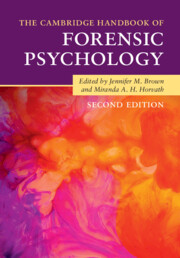Book contents
- The Cambridge Handbook of Forensic Psychology
- The Cambridge Handbook of Forensic Psychology
- Copyright page
- Dedication
- Contents
- Figures
- Tables
- Contributors
- Preface
- Forensic Psychology
- Part I Psychological Underpinnings
- 1.1 Cognitive Theories of Crime
- 1.2 Child and Adolescent Offending
- 1.3 Investigative Psychology
- 1.4 Neurological Theories
- 1.5 Personality
- 1.6 Theories of Sexual Offending
- 1.7 The Psychology of Violent Behavior
- 1.8 Investigative Decision-Making
- Part II Psychology and Criminal Behaviour
- Part III Assessment
- Part IV Interventions
- Part V Civil Proceedings
- Part VI Professional Practices
- Index
- References
1.5 - Personality
from Part I - Psychological Underpinnings
Published online by Cambridge University Press: 02 December 2021
- The Cambridge Handbook of Forensic Psychology
- The Cambridge Handbook of Forensic Psychology
- Copyright page
- Dedication
- Contents
- Figures
- Tables
- Contributors
- Preface
- Forensic Psychology
- Part I Psychological Underpinnings
- 1.1 Cognitive Theories of Crime
- 1.2 Child and Adolescent Offending
- 1.3 Investigative Psychology
- 1.4 Neurological Theories
- 1.5 Personality
- 1.6 Theories of Sexual Offending
- 1.7 The Psychology of Violent Behavior
- 1.8 Investigative Decision-Making
- Part II Psychology and Criminal Behaviour
- Part III Assessment
- Part IV Interventions
- Part V Civil Proceedings
- Part VI Professional Practices
- Index
- References
Summary
In conjunction with situational and circumstantial factors, personality is a common influence contributing to the tipping point at which an offence occurs. People without these traits in similar circumstances are better able to eschew risky situations. The ultimate cause of ostensibly antagonistic traits is in evolved behavioural mechanisms which continue to be useful in harsher socioecological niches. Antagonistic traits often function alongside more positive co-operative and empathic traits, both having contributed to human survival over millennia. A huge body of psychometric and multivariate work with offenders involving large samples and longitudinal samples indicates five-factor, HEXACO, Dark Triad and other trait description schemes corroborate one-another regarding the key trait influences on offending. These models map onto DSM and ICD-10 personality disorder models, suggesting personality disorders have a foundation in trait dispositions. Work is needed to identify better behavioural measures of these dispositions, and how they integrate into cognitive and desistance processes.
- Type
- Chapter
- Information
- The Cambridge Handbook of Forensic Psychology , pp. 88 - 108Publisher: Cambridge University PressPrint publication year: 2021



